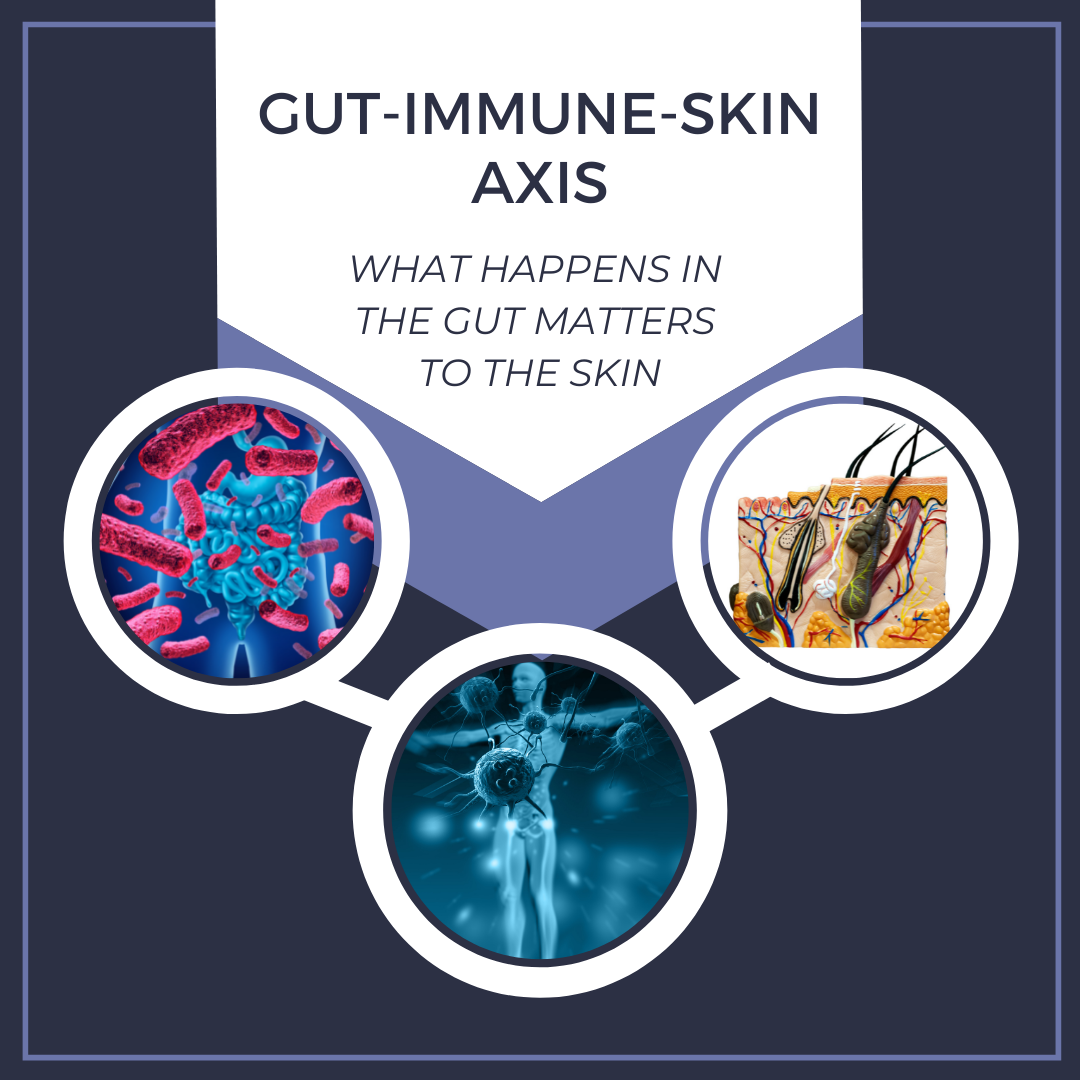The gut-immune-skin axis describes how the gut microbiome communicates with the skin via complex interactions with the immune system to regulate local and systemic inflammation. Before attempting to delineate that relationship, we must first grasp a firm understanding of the gut ecosystem. The gut ecosystem is made up of the epithelial interface, which is characterized by
-
- the epithelial lining
- the gut microbiota
- the gut microbiota’s metabolites (short chain fatty acids (SCFA), neurotransmitters, vitamins, exosomes, etc).
The biodiversity of that ecosystem is vital for proper gut-immune-axis homeostasis. Gut biodiversity relies on keystone species given that the entire biodiversity changes due to what each bacterial species does to the ecosystem. In other words, gut biodiversity is more about what each bacterial species actually does than the numbers or types of gut bacterial species. In addition, the ecosystem is subjected to both intrinsic and extrinsic human modulations. Intrinsic modulation results from factors innate to the ecosystem such as mucous (sIgA) production, anti-microbial peptides, stress-hormones whereas extrinsic modulation is mediated by food/diet, water, medications or topicals (skin).
The ecosystem biodiversity depends not on the number or types of bacterial species but on what each species actually does to the ecosystem.
The importance of biodiversity for proper gut-immune-axis homeostasis is supported by the literature surrounding the use of fecal microbiota transplant (FMT). FMT entails delivery of healthy stool from a healthy donor to a recipient’s colon via colonoscopy, capsule, NG tube, enema. In a healthy gut, normal healthy commensals are producing several metabolites (SCFA) and normal mucous (sIgA) production to fight pathogen as well as anti-inflammatory cytokines to maintain gut homeostasis.
Dysbiosis occurs when there is a rise in the number of pathogen and decrease of commensal bacteria. This leads to diminish gut barrier function, invasion of these pathogen across that epithelial barrier, increase pro-inflammatory cytokines that get into the blood stream and circulate systemically resulting in skin dysbiosis. FMT works because it restores a disease (dysbiosis) state to health. The mechanism, however, remains to be elucidated.
Emerging evidence suggests that gut microbiota’s metabolites, aka post-biotics, are able to communicate with human tissues. This raises the question “What if it is the gut microbiota metabolites that matter?” Writing inGastroenterology, Ott et al. highlighted that sterile filtrate of FMT helps restore gut dysbiosis. The group demonstrated that sterile filtrate of FMT was still effective at treating C. diff infection and modulating the recipient’s microbiome. Thus, it turned out that gut microbiota didn’t have to be alive to work, supporting the notion that their metabolite matters too. The clinical application for FMT is extensive. In fact, several clinical trials are underway attempting to assess FMT’s efficacy at treating various disease including cutaneous dermatosis such as atopic dermatitis, alopecia areata and psoriasis.
It’s not which microbes are there; it is what they are doing: dead bacteria work.
Metabolites are key to communications. Interestingly, in any given local microbiome, microbes vary while the metabolic pathway remains stable, aka the metabolites remain the same. This further supports that it is not just the microbes that matter rather it what they are producing. Importantly, metabolites (lipids, peptides, polysaccharides, bile acids) are all directly affecting the immune system. For example, oral probiotics and tryptophan impact wound healing through modulation of the immune-metabolite interface. In a mouse model of atopic dermatitis, oral supplementation with metabolites of L-tryptophan resulted in improved skin and immune reaction. In a similar fashion, SCFA are important metabolites and ultimately affect the entire body. Topically, SCFA impacts the skin as well, reducing pro-inflammatory cytokines (IL-6, 17) while increasing anti-inflammatory cytokines (IL 10, IL 18). Together, this suggests that post-biotic may be effective in treatment of cutaneous dermatoses.
Consider topical metabolites rather than probiotics for the skin.
So what happens if the ecosystem biodiversity is loss? Evidence supports the dietary loss of microbial diversity over generations. This is important as the microbial diversity reflects the diversity in metabolites. Simply put, loss of diversity is bad. Loss of biodiversity is associated with increase obesity, hemoglobin A1c, glucose, BMI, TG.
The loss of biodiversity of the ecosystem is bad.
How do we restore or maintain biodiversity of the gut ecosystem? This can be accomplished via two ways:
-
- Precision diet and drugs
The gut microbiome can be used as biomarker to predict responsiveness to diet. By analyzing the gut microbiome, we can determine which diet to give to supplement for missing metabolites, restoring the diversity.
-
- Diverse diets
The American gut project in San Diego, concluded that it doesn’t matter which type of diet you are on. What matters is the diversity of the diet. Eating more than 30 types of plans per week helps maintain microbiome diversity.
Eating more than 30 types of plans per week helps maintain gut microbiome diversity.
So, how does skin-gut axis work? Stress leads to production of stress hormones which will affect the gut. What the gut microbiota chooses to produce in response to stress depends on your diet and environmental stimuli. The metabolites they produce, then enter the blood stream and circulate systemically to affect skin, skin microbiota and skin diseases. In summary, the gut-immune-skin axis communicates via metabolites which circulate systemically.
What happens in the gut matters to the skin.
The above article was written by Dr. Cula N. Dautriche (DIRAC member) and represents his/her interpretation of the information presented by Dr. Zwickey, during his lecture ” Gut-Immune-Skin Axis” at the 2020 Integrative Dermatology Symposium.
Did you enjoy this article? Find more on Integrative Dermatology here.

